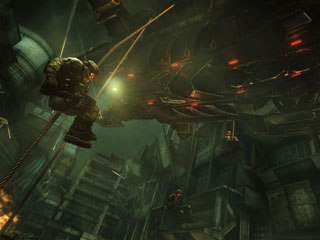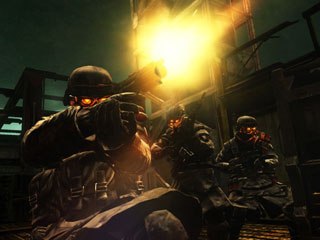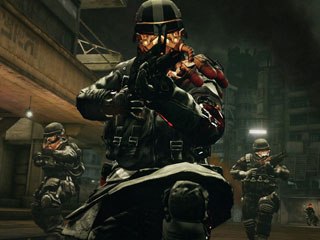Pete Rizkalla chats with the Killzone 2 team at Guerrilla Games about how they created the game under fire from media and fanboys after the 2005 trailer was shown.
I have to say, I looked at Sony with pride when they showed off that gorgeous Killzone 2 trailer for the PlayStation 3 at E3 2005. I thought they shot themselves in the foot again when they said that the trailer was actual, in-game footage, but after seeing and playing Killzone 2 now that it is released, I am very impressed.
I sat down with the Guerrilla Games team that created the visuals for Killzone 2 to find out exactly how they put together this big chunk of eye candy. First, the story: players take control of Sgt. Tomas "Sev" Sevchenko. Sev and his team are at war with the Helghast army, which is lead by the dictatorial antagonist Scolar Visari. The whole game looks like a post-apocalyptic Earth but it actually takes place on the alien world of Helghan. The Helghast army are not your typical videogame aliens but rather they're humanoid soldiers with slight differences from Earth humans. The game treats you to a gorgeous looking speech by Scolar Visari, who exhibits some outstanding facial animations and texture mapping.
Lead Tech Artist at Guerrilla Games, Paulus Bannink, says all of the animation was done in Maya, with only some of the motion capture being cleaned up a little in MotionBuilder. Right off the bat, this game is out of the ordinary considering that most 3D games have been developed using Autodesk's 3ds Max.
Bannink says, "If you can supply people with proper custom solutions they don't really care what tool they have to use, as long as they can get their job done." Speaking of custom solutions, Bannink adds that the 3D artists, animators and level designers all worked in Maya together. "In order to support these different disciplines in the same software we developed a large library of custom Maya tools and scripts. We have a few pieces of internally developed software for working with very specific game related systems like animation blending, destructible objects and particles. From a technical point of view it is very practical to have everyone work in the same environment, especially from a point of sharing assets between different departments."
Guerrilla Games Art Director, Jan-Bart van Beek, also chimes in on the art and animation of Killzone 2. "Aside from the usual off-the-shelf software like Maya, MotionBuilder, Houdini and Photoshop; most of our tools for both the art and design departments are custom made. Even Maya has been largely rewritten by Guerrilla engineers and so we're now running a different version of Maya then the rest of the world." Van Beek says they completely did away with Maya's viewport rendering software and added their own tools such as a lightmap rendering software called Hyperion.
AnimationBlender is another tool they built to edit and create in-game animation. AnimationBlender, almost a decade old, was used as the model for other programs like NaturalMotion. The Guerrilla engineers also created a tool that helps the developers edit particle effects dubbed the Particle Editor. Another of their custom tools that really piqued my interest is something they call ColorTweaker, allowing the team to make color corrections in realtime on the PS3.
The animation in Killzone 2 is mostly motion-capture but Van Beek says there are certain aspects of the game that they much preferred to animate by hand instead. "One important part that we always hand-animate are the reload animations."
Multiple techniques were used to create the facial animation in Killzone 2, one for each particular in-game circumstance.
Bannink elaborates, "Our facial animation system is based on blendshapes, with bones for the jaw and the eyes. The main reason for going with blendshapes was the relative ease with which they can be transferred to different faces; it would also provide a more artist-friendly way of editing the facial animation rig. In our case, character artists were literally able to sculpt the various expressions that our characters would have to reach."
Regarding the facial animations in the first crucial cut scene featuring Scolar Visari, Bannink says, "Most of the cut scene facial animation was done with marker motion capture, although at the end of the project we did do a quick animator pass of most of these animations." The generic facial animations for in game dialog -- or "battle chatter" -- was a different story altogether. The Guerrilla devs used an automated process within MotionBuilder which, after plugging in audio files, would create generic facial animations. This is the same process of developing facial animations used for in-game dialog that was found in the development of Ubisoft's most recent Prince of Persia title.
Senior Producer Steven ter Heide was tasked with sewing all the elements together. "We had developers not just on the canals in Amsterdam, but people working out of New Zealand, Australia, Japan, Korea, the U.K. and the U.S. Killzone 2 takes a few gigabytes and sending such huge files around the globe has pushed our patience and the Internet connection to its limits."
As if managing an exorbitant amount of enormous files wasn't hard enough, the biggest challenge on Killzone 2 was, "Having to stay quiet, and not respond to the forums to defuse the situation after our 2005 trailer. The only way we knew we could defuse it would be putting the controller in people's hands and let them play it."
A lot of the media were skeptical that the final in-game footage of Killzone 2 would not be as gorgeous as the 2005 trailer. I was a little nervous about that claim myself, but from the looks of things it seems Guerilla did a bang up job keeping Killzone 2's quality up to their own standard. If given the opportunity, could Guerrilla have made Killzone 2 for the Xbox 360? The answer was a resounding "No." "We have made our engine from the ground up based on the capabilities of the PS3. The game as it looks and plays now would not have been possible on 360."
Any good FPS has to have an online multiplayer aspect to it and Killzone 2 is no different. Attempting to combat the already stiff online competition laid down by the Call of Duty franchise, senior online game designer Eric Boltjes describes what has been done for Killzone 2's multiplayer modes. "One thing that makes Killzone 2 multiplayer quite unique is the way we have set up our missions," he says. "We have created a system we call Dynamic Missions, and what this does is that it switches between different mission objectives during a single round, really changing gameplay during the span of one game. What this system also accomplishes is a new layer of tactical gameplay, as you now have to think about the next mission as well as your current one."
Killzone 2's multiplayer aspect features more tournaments, clans, customizable games, bots, badges and more.
What do the developers at Guerrilla think defines a great game? Van Beek happily replied, "Just the right amount of fun, just the right amount of frustration. I like a game that makes me yell out and punch a pillow once in a while." Killzone 2 feels kind of like a mixture of Call of Duty and Fallout 3 with just a little bit of Gears of War thrown in there. Does it make me yell out? Not really. If I was one of the guys that worked on Killzone 2, then I would probably yell out. Get some rest, fellas.
Peter Rizkalla is a life long enthusiast of videogames and the videogame industry. He has worked in various videogame companies such as THQ, Namco/Bandai and 2K Games and avidly attends many game conferences and events. Peter can be reached at PRizkalla@gmail.com.












